ISSN 2410-5708 / e-ISSN 2313-7215
Year 12 | No. 35 | October 2023 - January 2024
© Copyright (2023). National Autonomous University of Nicaragua, Managua.
This document is under a Creative Commons
Attribution-NonCommercial-NoDerivs 4.0 International licence.
Follow-up and therapeutic approach provided to women with intraepithelial Cervix lesions who are treated at the Leonel Rugama Health Center, Estelí, Nicaragua, 2021
https://doi.org/ 10.5377/rtu.v12i35.17005
Submitted on 08 th May, 2023 / Accepted on 11 th October, 2023
María Teresa Sevilla Sevilla
Ministry of Health, MINSA, Nicaragua.
Sofía Lacayo Lacayo
Center for Health Research and Studies (CIES /
UNAN-MANAGUA), Nicaragua.
Section: Health & Human Services
Scientific research article
Keywords: Premalignant lesions, Cervix, Follow-up, Therapeutic approach, Cervical cytology, Cryotherapy, cone by loop.
Abstract
Currently, cervical intraepithelial lesions are one of the most frequent public health problems. Most cervical cytology tests in sexually active women have up to 76% altered results and the prevalence rate of low-grade premalignant cervical lesions is 12.16%; This is because these are the ones that precede high-grade lesions and cervical cancer.
Objective. Describe the follow-up and therapeutic approach provided to women with intraepithelial lesions of the cervix who are treated at the Leonel Rugama health center, Estelí Nicaragua in 2021.
Material and methods: A retrospective cross-sectional observational descriptive study was carried out with 122 affected women. We took the inclusion criteria into account and created a sample of 93 women, calculated with OpenEpi, version 3.
Results: According to the socio-reproductive characteristics of the women studied, the most affected age group is those over 35 years of age, of rural origin, accompanied marital status, with an incomplete primary schooling level, housewives, of the Catholic religion, started life sexually active 15-19 years old.
Conclusion: The high incidence of HPV infection leads to low- and high-grade lesions and also contributes to increase mortality associated with cervical cancer, we must highlight the importance of cervical cancer prevention programs through screening with cervical cytology and vaccination to prevent HPV.
Introduction
Intraepithelial lesions of the cervix are currently one of the most frequent public health problems. If women are infected within the first three years of becoming sexually active, without proper diagnosis and management, they can develop cervical cancer, which is the second leading cause of cancer-related death in women (Sung et al., 2021).
It is estimated that around 604,000 cases of invasive cervical cancer are diagnosed annually in the world, representing 12% of all cancers detected in women, of which 56% are fatal.(Mailhot Vega et al., 2019).
Most cervical cytologies in sexually active women have up to 76% altered results and the prevalence rate of low-grade premalignant cervical lesions is 12.16%; this is because these are the ones that precede high-grade lesions and cervical uterine cancer, hence the importance of timely detection and treatment.
Early diagnosis of cervical cancer with timely treatment is an important measure to control the neoplasm and improve the prognosis of women’s lives. The World Health Organization promotes screening as an effective and low-cost tool for early detection of premalignant lesions.
Cure depends on the size of the lesion, the involvement of endocervical glands, the status of any excisional margins, and the results of endocervical curettage. Most high-grade lesions persist or progress, so immediate treatment is indicated in these patients, as well as post-treatment follow-up to avoid the appearance of complications and to evaluate the effectiveness of the implemented therapy.
To this end, the management and prioritization of actions aimed at women exposed to epidemiological risk factors should be strengthened. This research aims to evaluate the follow-up and therapeutic approach provided to patients treated in this unit.
Material and methods:
Type of study:
A descriptive, observational, retrospective, and cross-sectional study, in which the treatment provided to women with cervical lesions treated in the lesion clinic of the Leonel Rugama health center in 2021 was evaluated.
According to the research method the present study is observational and according to the initial level of depth of knowledge: descriptive (Piura, 2006), according, to the time of occurrence of the facts and recording of information the retrospective study and by the period and sequence of the cross-sectional study (Canales, Alvarado and Pineda, 1996).
Study area:
Gynecology service of the Leonel Rugama health center of the municipality of Estelí.
Universe:
122 women with cytological and histological diagnoses of cervical intraepithelial lesions attended the gynecology area of the Leonel Rugama health center year 2021.
Sample:
Taking into account the selection criteria we left a sample of 93 women calculated with OpenEpi, version 3, the open source calculatorSSPropor with a confidence interval of 95%. Because we took into account inclusion criteria, we did not take the entire universe since pregnant women were excluded because they do not undergo procedures when they are in that state.
Population size: 122
Anticipated frequency %: 50
Confidence limits: 1%.
Design effect: 1.0
Sample calculated at 95% confidence
according to OPEN EPI ( https://www.openepi.com/SampleSize/SSPropor.htm)
Unit of analysis:
Women with intraepithelial lesions of the cervix seen at the Leonel Rugama health center.
Results
According to the objectives, the following results were obtained. To describe the socio-reproductive characteristics of women with intraepithelial lesions of the uterine cervix under study.
Figure 1
Age of the women studied, who attended at the Leonel Rugama health center, Estelí Nicaragua year 2021.
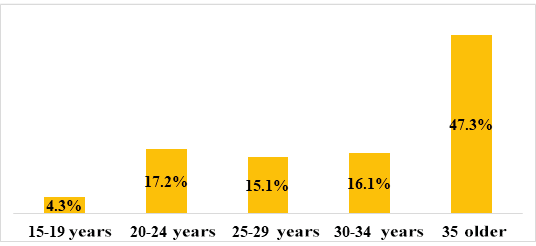
Source. Database of the data collection instrument.
According to the socio-reproductive characteristics of the women studied, the most affected age group is those older than 35 years.44 out of 93 women studied have had intraepithelial lesions of the uterine cervix.
Figure 2
Origin of the women studied, who are attended at the Leonel Rugama Health Center, Estelí Nicaragua year 2021.
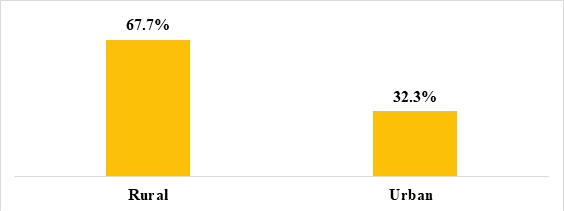
Source. Database of the data collection instrument.
According to the origin of the women studied, the highest percentage of women who presented intraepithelial lesions of the neck were from rural areas; of the 93 women studied, 63 were from rural areas and 30 from urban areas.
Figure 3
Schooling of the women studied, who are attended at the Leonel Rugama Health Center, Estelí Nicaragua year 2021.
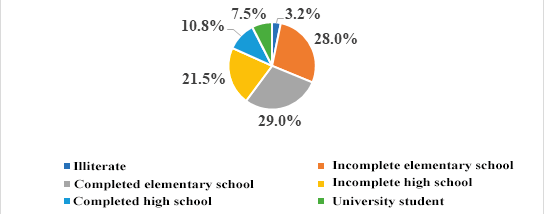
Source. Database of the data collection instrument.
The level of schooling of the women studied shows that according to schooling, the most affected with low-grade intraepithelial lesions are those who have incomplete or complete elementary education.
Figure 4
Occupation of the women studied, who are attended at the Leonel Rugama Health Center, Estelí Nicaragua year 2021.
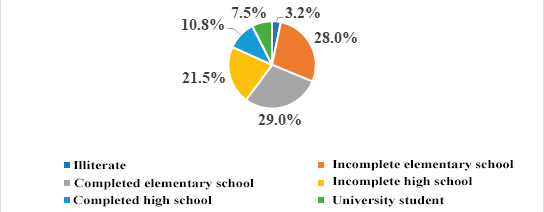
Source. Database of the data collection instrument.
The occupational level of the women studied who have presented intraepithelial lesions of the uterine cervix has the highest percentage as housewives, 81 of the 93 women studied are of this occupation.
Figure 5
Beginning of sexual life of the women studied, who are attended at the Leonel Rugama Health Center, Estelí Nicaragua year 2021.
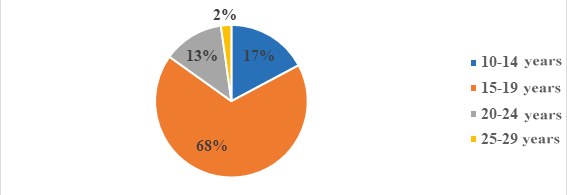
Source. Database of the data collection instrument.
The highest percentage of women who began their active sexual lives were in the 15-19 years age group. Of the 93 that were studied, 63 belong to this group.
Figure 6
Type of colposcopic diagnosis of the women studied, who are attended at the Leonel Rugama Health Center, Estelí Nicaragua year 2021.

Source. Database of the data collection instrument.
The women studied who presented intraepithelial lesions of the neck after colposcopic evaluation suffered from CIN I, since 66 of the 93 women studied presented this classification.
Figure 7
Type of therapeutic approach of the women studied, who are treated at the Leonel Rugama health center, Estelí Nicaragua year 2021.

Source. Database of the data collection instrument.
The women studied with intraepithelial lesions of the neck underwent treatment to directly treat the lesion, 88 of them underwent cone biopsy, followed by cryotherapy.
Discussion of results.
The age of the women studied with intraepithelial lesions of the neck, the most affected is the age group over 35 years with 47.3%, with a frequency of 44, followed by women aged 20-24 years with 17.2% and a frequency of 16 women.
We relate this result to the study of Wangu & Burstein (2017) that states that half of new infections occur in young people between 15 to 24 years and 75% to 80% of sexually active adults will acquire genital HPV infection before the age of 50 years, Due to such a situation it is very important the initiation of screening, surveillance period or cytology interval mainly in women suffering from lesions as an appropriate measure to give time to the lesion and HPV to achieve its regression.
According to origin, the most affected women are from the rural areas with 67.7% and a frequency of 63, which corresponds to the access to information of people from the rural area, We relate it to the study of Celso Velázquez, A.K. (2018). Prevalence of cervical cancer precursor lesions and sexual and reproductive history points out that a higher percentage affected was from the urban area, which contradicts our research %, (8) urban in 62.8%. Therefore, we should work on prevention in both areas.
About the marital status of the women surveyed we have that 68.8% are accompanied with a frequency of 64 followed by,26.9% married with a frequency of 25, and 4.3% are single with a frequency of 4. Previous studies reveal that single women living in promiscuity have higher rates of premalignant lesions. In this case, most of the women are accompanied by what we relate to frequent change of partner.
According to the degree of schooling we have that the highest percentage is more than 50% in two categories, staff with incomplete primary and complete primary both have 57% with a frequency of 53, followed by 20% of incomplete secondary with a frequency of 53.
The low academic level is related to a high incidence of cervical premalignant lesions, and women with low educational levels are more likely (1.6 times more) to develop cervical uterine cancer. Since this is translated into a lack of knowledge and misinformation on the part of women and they do not take adequate protective measures. We relate this study to that of Ledesma López. V. (2018). In her study of epidemiological profile and some social determinants of Mexican women with cervical lesions, she points out that 51% of the women who participated in this study attended only primary school or are illiterate, which is consistent with what Sanfilippo et al. describe in an investigation that showed that 84% of the women who died from cervical uterine cancer had primary schooling or were illiterate. This disease is related to poverty and low education, and this also constitutes a kind of barrier to access to cervical cytology and treatment adherence.
According to the occupation of the respondents we have the highest percentage of housewives with 87.1%, with a frequency of 81, followed by women of working occupation with 4.3% and a frequency of 4. This result relates to the study of Velázquez, C. (2018). The prevalence of cervical cancer precursor lesions and sexual and reproductive history point out that the most affected in her study were housewives. The ages of indigenous users are mostly young people aged 15 to 39 years, a range that corresponds to the reproductive period, active sexual life, and exposure to various diseases that affect the genital area, in turn mostly housewives, similar to what was found by Ruiz JM et al (2016), in a population that in 56.6% corresponded to ages between 20 to 34 years, also with a higher frequency of housewives 46.5%.
Regarding religion, 77.4% are Catholic with a frequency of 72, and 22.6% are Evangelical with a frequency of 21, coinciding with the most frequent ideology in our country.
The highest percentage had their first sexual intercourse between 15-19 years of age with 67.7% and a frequency of 63, followed by women between 10-14 years of age with 17.2% and a frequency of 16.
The risk of intraepithelial lesion when the first sexual intercourse takes place at 17 years of age or younger is 2.4 times higher than when the first sexual intercourse takes place at 21 years of age. According to the study by Ledesma López. V. (2018). In her study of epidemiological profile and some social determinants of Mexican women with cervical lesions.203 (67.89%) participating women initiated their sexual life at 18 years of age or earlier. According to the literature, 23% of the women began their sexual life in adolescence (between 15 and 19 years of age) and without protection. This predisposes them to sexually transmitted infections (STIs) and unwanted pregnancies and places them in a situation of poverty, which in turn perpetuates their poor health by negating the opportunity to study, obtain employment, and have access to better living conditions.
The number of children of women with intraepithelial lesions of the uterine cervix 40.9% have two children with a frequency of 38, followed by 24.7% who have had one child with a frequency of 23, in third place, we have 10.8% had three children with a frequency of 10. In a multicenter study carried out by annual revolving internship, it has been established that women with two or more children have an 80% higher risk of presenting intraepithelial lesions than nulliparous women; after four children this risk triples, after seven it quadruples and with twelve it increases five times.
Women with one or more vaginal deliveries have a 70% higher risk of intraepithelial lesion, compared to those with only cesarean deliveries. The reason for this association is repeated trauma to the cervix at the time of delivery.
Velázquez, C. (2018) Prevalence of cervical cancer precursor lesions and sexual and reproductive history, points out that this study found a higher frequency of cervical cancer precursor lesions in indigenous women who had menarche before the age of 12 years in 7.8%, first sexual contact < 15 years 10.1% and in large multiparous women 10.8%. This is consistent with the work done by Ávila D et al, who found a higher frequency in women with early menarche (5.7%), in those who began their sexually active life early (5.1%), and in those who had one or more pregnancies (4) (4) (4.1%). In all cases, a statistically significant association was found between general characteristics and sexual/reproductive history.
According to the analysis of abortions presented in the patients studied, 79.6% did not present any abortion with a frequency of 74, followed by 18.3% presented one abortion with a frequency of 17, and lastly, 2.2% presented 2 abortions with a frequency of 2. According to The study by Liria del Castillo O. (2017) Risk factors and premalignant lesions of the cervix in women who attended at the health center Punta in the district of Tarapoto,184 women (65%) said they had not had any abortion, while 26% (73 women) said they had had one. As for the item: two or more abortions, 9% (26 women) of the cases attended. None of the factors related to reproduction were significant.
Regarding the presence of STIs, we found that 93.5% did not present STIs, with a frequency of 87 and 6.5% presented abortions with a frequency of 6. M. (2019) Risk factors in intraepithelial lesions of the cervix sexually transmitted diseases, especially those caused by the so-called oncoviruses, in which infection by the human papillomavirus (HPV) is considered the main cause, coexist with the human being since sexual initiation, It is known that intraepithelial neoplasms begin as a sexually transmitted disease through the papillomavirus, which produces lesions in the epithelia of the urogenital apparatus, both in men and women, which slowly and progressively evolve into cancer, if not treated.
Regarding the number of sexual partners, 135 (45%) women had a sexual partner and it is said in the literature that polygamous practices are exercised mainly by men and that they are more at risk of contracting an STI and infecting their partner.
According to the history of cervical cytology performed by patients, 84.9% of women have it done every year with a frequency of 79, followed by 11.8% every two years with a frequency of 11, and 2.2% every 6 months, with a frequency of 2, related to the study by Ramos Duharte D. (2020). Risk factors of premalignant lesions of the cervix in reproductive age. Omar Ranedo Polyclinic. Where there is a predominance of performing the examination every 3 years with a representation in the group of cases of 80.9% and in the group of controls 83.2% having a protective association with an OR= 0.40 IC95% (0.27-0.58). Gajardo Macarena in her research describes that 76.5% of the women (n=741) reported having a PAP in the last 3 years. Of the women who do not have an updated PAP (n=228), 14% have never had a PAP and 865 reported having it more than 3 years ago.
Knowledge of the requirements for having a PAP determines whether a woman is considered in or out of the target population. Many women think that PAP is only performed if there are symptoms.
It has been described that women of childbearing age, without cervical cytology, have a 3 times higher risk of presenting the disease than women with an up-to-date exam. In addition, the incidence and mortality from invasive cancer is much higher in older women who have never been screened. Between 40% to 50% of women who die from cervical cancer are over 65 years of age and in some high-risk populations, up to 75% of women over 65 years of age have been found to have had no screening cytology in the last 5 years.
According to the planning methods used by the women under study, 46.2% use condoms with a frequency of 43, followed by 19.4% use surgical sterilization with a frequency of 18, and 11.8% use injectable methods. With a frequency of 11.
Analyzing the study of Velázquez. C (2018) Prevalence of cervical cancer precursor lesions and sexual /reproductive history of indigenous people of Caaguazú, Paraguay 2015-2017. It says that 90.70% (117/129) of women used natural contraceptive methods, and 41.86% (54/129) of indigenous women stated that it was the first time they had the PAP.
According to the type of lesion found we have that 95.7% of the lesions are low grade with a frequency of 89 and 4.3% high grade with a frequency of 4. Which we relate to the study of Velázquez. C. (2018). Prevalence of cervical cancer precursor lesions and sexual/reproductive history of indigenous women from Caaguazú, Paraguay 2015-2017. The 22 records that were excluded for analysis, 40.9% (9) corresponded to ASC-US (atypical squamous cells of undetermined significance), 27.3% (6) to LEIBG (low-grade squamous intraepithelial lesion), 22.7% (5) to LEIAG (high-grade squamous intraepithelial lesion) and 9.1% (2) to ASC-H (atypical squamous cells, the high-grade lesion cannot be ruled out).
Garcia Lopez. T. (2017). Evaluation of a cervical cancer screening program in Colombia. Of the abnormal cytological results (564) the most frequent were ASC-US with 66.8% followed by LEIBG with 27%, and the least frequent, glandular squamous cell carcinoma and atypical glandular cells with no other significance with 0.2% When evaluating the presence of two simultaneous risk factors for CCU, 14.7% were found present socioeconomic stratum 1 and parity ≥ 3 and with 15.4% urban area and cytology taking outside regular scheme. Of the total number of biopsies/colposcopies taken (522), the distribution of cases was as follows: CIN I (Cervical intraepithelial neoplasia Grade I) presented the highest prevalence with 40.0% affecting in greater proportion the ages of 25 to 29 years (41), 30 to 34 years (46) and 35 to 39 years (31), followed by Negative for Neoplasia with 33.7% mainly in the ages of 45 to 49 years (29), 50 to 54 years (30) and 65 to 69 years (7). The remaining individual biopsy/colposcopy results obtained were below 10 Of the 42 cases in which there was no record of biopsy/colposcopy were cytological results: ASC-US with 59.5%, LEIBG with 35.7%, and LEIAG with 4.8%.
Type of lesion confirmed by colpobiopsy we have that 71.0% is CIN I, with a frequency of 66, followed by 20.4% who presented CIN II with a frequency of 19, and 6.5% presented CIN III with a frequency of 6.
In the Consensus newsletter conducted by the ASCCP (2019) based on the Guidelines for the management of premalignant lesions and prevention of cervical cancer, the age of 21 years was published as the most appropriate age to start screening for cervical cancer making some differences regarding the management of young women aged 21 to 24 years because of the high prevalence of transient infection and its frequency of regression of NICII from 39% to 65% at two years and the low incidence of cervical cancer in this age group, which is why they recommend cytology for follow-up of low-grade lesions instead of colposcopy. Daily et al. mention that the most recent guidelines were based on and derived from populations of low-risk women, mostly white, all with good access to healthcare facilities and low frequency of smoking. They point out that in this population the prevalence of CIN2 reported in women aged 21 to 24 years was 4.7% and CIN3 was 1.6%.
According to the Centers for Disease Control and Prevention (CDC, 2020), more than 200 types of HPV have been identified. Of these, approximately 40 preferentially infect the genital mucosa. Genital HPV types are categorized according to their epidemiological association with cancer. High-risk types such as types 16 and 18 can cause low-grade abnormalities of cervical cells and high-grade abnormalities that are precursors of cancer. Also, approximately 70% of cervical cancer cases worldwide are caused by types 16 and 18.
Procedures performed on the patients according to the lesion presented we have that the treatment received with active management in most cases was based on conization procedures 68.2% with a frequency of 88, 30.2% received cryotherapy with a frequency of 39.
Once the presence of an intraepithelial lesion of the cervix is detected, the patient should receive treatment to eradicate the abnormal epithelium and prevent it from progressing to a larger lesion.
The therapeutic options are multiple, ranging from fertility-preserving methods to hysterectomy. All of them are based on the removal of the transformation zone, where the intraepithelial disease settles. According to FECASOG (2019) in its Guidelines mention the four successive steps that exist for the development of cervical cancer and should be treated with ablative and resection methods. It is very important to make it clear that, if any suspicion of invasive cervical cancer is found, the patient should NOT be treated by these methods, and should be referred immediately to a specialized center for proper management (radiotherapy or radical surgery).
The follow-up received by the patients was effective in 84.9%, where the patients were discharged with all their studies carried out with a frequency of 79. 4.3% are still under active treatment according to protocol, which exceeds even more the percentage of adequate follow-up. We have 4.3% of abandonment with a frequency of 4 and 6.5% without adequate follow-up with a frequency of 6.
According to the study by García, B. G. (2021). Evolution of premalignant lesions of the uterine cervix in women aged 15-24 years attended at the Hospital Alemán Nicaragüense, Managua. July 2015 June 2019. We analyzed 142 files of women in the age range of 15 to 24 years with a diagnosis of intraepithelial lesions of the cervix, the evolution of the lesions was observed a regression of 70.42%, a persistence of 23.23%, and a progression of 6.33%. In the final state of the patients, 2.11% (3) dropped out, 84.50% were discharged with negativity of the lesion, and 13.38% continued to be followed up. These results are in agreement with numerous studies on the prevalence of high and low-risk HPV and reinforce the recommendations of FECASOG (2019).
CONCLUSIONS
It is concluded in this study that intraepithelial lesions of the cervix are mostly affecting women aged 35 years and older, from rural areas, women who are not married and have a common-law relationship or are accompanied by a low level of incomplete primary schooling, housewives, of Catholic religion, with a start of sexual life from 15 to 19 years, without hormonal planning methods since most use condoms.
According to the cytological findings found in the cervical cancer screening by cervical cytology we have that women are having their cervical cytology for more than one year, the type of lesions that women are suffering most are low-grade lesions, mostly CIN I.
According to the therapeutic approach, most of the women were treated according to the degree of the lesion with LEEP, followed by cryotherapy, and were kept under active follow-up according to protocol in the lesion clinic until they completed their evaluation and follow-up studies to assess their discharge with follow-up at the health post during the period recommended by the lesion standard, so we can say that we had a very good effectiveness of the cancer program.
Works Cited
Arbyn, M., Smith, S. B., Temin, S., Sultana, F., & Castle, P. (2018). Detecting cervical precancer and reaching underscreened women by using HPV testing on self-samples: updated meta-analyses. BMJ, k4823. https://doi.org/10.1136/bmj.k4823
Basu, P., Taghavi, K., Hu, S.-Y., Mogri, S., & Joshi, S. (2018). Management of cervical premalignant lesions. Current Problems in Cancer, 42(2), 129-136. https://doi.org/10.1016/j.currproblcancer.2018.01.010
Blandón Ruiz, M. d. l. Á. (2020). Calidad en las intervenciones para el tratamiento de lesión escamosa intraepitelial de alto grado en cérvix, diagnosticadas en el Hospital Regional César Amador Molina-Matagalpa, enero a diciembre del 2015.
Celso Velázquez, A. (2018). Prevalencia de lesiones precursoras del cáncer del cuello y antecedentes sexuales y reproductivas
Dexeus.D. España (2020) Prevención y tratamiento de las lesiones cervicales de bajo grado causadas por VPH: evidencias de un gel vaginal basado en Coriolus versicolor.
De Sousa. K. Venezuela (2019) Prevalencia de lesiones intraepiteliales cervicales de bajo y alto grado en pacientes en edad fértil. Maracaibo. Estado Zulia
Frias-Gomez, J., Benavente, Y., Ponce, J., Brunet, J., Ibáñez, R., Peremiquel-Trillas, P., Baixeras, N., Zanca, A., Piulats, J. M., Aytés, Á., Matias-Guiu, X., Bosch, F. X., Sanjosé, S., Alemany, L., & Costas, L. (2020). Sensitivity of cervicovaginal cytology in endometrial carcinoma: A systematic review and meta-analysis. Cancer Cytopathology, 128(11), 792-802. https://doi.org/10.1002/cncy.22266
González Valdivia, F.A. (2021) Seguimiento y evolución de lesiones intraepiteliales de alto y bajo grado en las pacientes tamizadas con citología cervical en el año 2018 y 2019, Municipio San Pedro de Lóvago y Santo Tomás, Chontales
Guido Ramos R.A (2017) Jinotega Nicaragua. Evaluación de lesiones escamosas intraepiteliales de bajo y alto grado (LEIBG-LEIAG) en mujeres atendidas en la clínica integral Blanca Nubia Picado. Hospital victoria Motta, Jinotega I semestre 2016
García López. T. Colombia (2017) Evaluación de un programa de detección temprana de cáncer cervicouterino en Colombia
Hidalgo Narváez D.S. (2018) Frecuencia y resultados de electro fulguración en el manejo de lesiones escamosas intraepiteliales de bajo grado del cérvix.
Ledesma López. V. (México)2017 Perfil epidemiológico y algunas determinantes sociales de mujeres mexicanas con lesiones intraepiteliales cervicales en el Hospital Juárez de México y la Clínica Integral de la Mujer.
Lima. M.G. Venezuela (2017) Seguimiento clínico de pacientes con diagnóstico de lesiones intraepiteliales de bajo grado de cérvix. ambulatorio maría teresa Toro, Maraca y, Venezuela.
Mailhot Vega, R. B., Balogun, O. D., Ishaq, O. F., Bray, F., Ginsburg, O., & Formenti, S. C. (2019). Estimating child mortality associated with maternal mortality from breast and cervical cancer. Cancer, 125(1), 109-117. https://doi.org/10.1002/cncr.31780
Narváez Flores M. L Carazo. 2019.caracterización de mujeres con lesión intraepitelial de alto grado (LIEAG) basada en citología cervical, para la prevención de cáncer cervicouterino en el silais Carazo, Nicaragua. Enero a diciembre 2018.
Perkins, R. B., Guido, R. S., Castle, P. E., Chelmow, D., Einstein, M. H., Garcia, F., Huh, W. K., Kim, J. J., Moscicki, A.-B., Nayar, R., Saraiya, M., Sawaya, G. F., Wentzensen, N., & Schiffman, M. (2020). 2019 ASCCP Risk-Based Management Consensus Guidelines for Abnormal Cervical Cancer Screening Tests and Cancer Precursors. Journal of Lower Genital Tract Disease, 24(2), 102-131. https://doi.org/10.1097/LGT.0000000000000525
Pyo, J.-S., Kang, G., Yoon, H. K., & Kim, H. J. (2019). Diagnostic Test Accuracy Review of Cytology for Squamous Intraepithelial Lesion and Squamous Cell Carcinoma of Uterine Cervix. Journal of Korean Medical Science, 34(2). https://doi.org/10.3346/jkms.2019.34.e16
Palma Osorio M. (2019) Factores de riesgo en las lesiones intraepiteliales del cuello uterino
Ramos Duharte D. CUBA (2020). Factores de riesgo de lesiones premalignas del cérvix en edad reproductiva. policlínico Omar Ranedo. 2020.
Sung H, Ferlay J, Siegel RL, Laversanne M, Soerjomataram I, Jemal A, et al. Global cancer statistics 2020: GLOBOCAN estimates of incidence and mortality worldwide for 36 cancers in 185 countries. CA Cancer J Clin. 2021:71:209–49. doi:10.3322/caac.21660.
Stelzle D, Tanaka LF, Lee KK, et al. Estimates of the global burden of cervical cancer associated with HIV. Lancet Glob Health 2020; publicado en línea el 16 de noviembre. DOI: S2214-109X (20)30459-
Sevilla Valdivia D.M (ESTELI) (2020). Seguimiento de mujeres diagnosticadas con lesiones de alto grado del programa de detección del cáncer uterino en el centro de salud Leonel Rugama-Estelí, período enero 2017- diciembre 2018
Sequera, V.-G., Mena, M., Hollmann, M., Mani, E., Ramas, V., Bonilla, S., Guerra, A., & Borgia, F. (2018). Identifying populations most susceptible to get benefit from broadening the scope for prevention of cervical cancer: Example from Uruguay. Papillomavirus Research, 5, 122-127. https://doi.org/10.1016/j.pvr.2018.03.004
Sung, H., Ferlay, J., Siegel, R. L., Laversanne, M., Soerjomataram, I., Jemal, A., & Bray, F. (2021). Global Cancer Statistics 2020: GLOBOCAN Estimates of Incidence and Mortality Worldwide for 36 Cancers in 185 Countries. CA: A Cancer Journal for Clinicians, 71(3), 209-249. https://doi.org/10.3322/caac.21660
Tainio, K., Athanasiou, A., Tikkinen, K. A. O., Aaltonen, R., Cárdenas, J., Hernándes, Glazer-Livson, S., Jakobsson, M., Joronen, K., Kiviharju, M., Louvanto, K., Oksjoki, S., Tähtinen, R., Virtanen, S., Nieminen, P., Kyrgiou, M., & Kalliala, I. (2018). Clinical course of untreated cervical intraepithelial neoplasia grade 2 under active surveillance: systematic review and meta-analysis. BMJ, k499. https://doi.org/10.1136/bmj.k499
Toro-Montoya, A. I., & Tapia-Vela, L. J. T.-V. (2021). Virus del papiloma humano (VPH) y cáncer. Medicina y Laboratorio, 25(2). https://doi.org/10.36384/01232576.431
